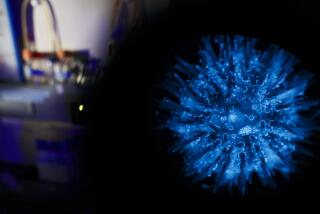Laser-guided ‘sea monkeys’ hint at secrets of ocean’s motion
Could tiny sea creatures, a few millimeters in length, be partly responsible for the large-scale motion of the ocean?
That’s the finding from a pair of Caltech researchers, who used lasers to herd brine shrimp around a tank and track their effects on the water’s movement. The results, published in the journal Physics of Fluids, show that ocean currents may be a function not only of large-scale physical phenomena like wind and tides, but also of living things.
------------
FOR THE RECORD
Oct. 1, 6:22 a.m.: An earlier version of this post indicated that brine shrimp live in the ocean. They live in saltwater lakes.
------------
Study coauthor John Dabiri, a Caltech fluid dynamicist, latched on to the idea a few years ago while studying how jellyfish move. He noticed something strange: As the jellyfish swam, they appeared to be carrying a lot of water with them.
Dabiri wondered if the same was true of smaller animals that fill the world’s oceans, including krill and copepods. Such animals rise up during the night to feed on phytoplankton and sink back into the darker depths during the day. Dabiri and graduate student Monica Wilhelmus wondered if such dramatic vertical migrations – in some cases, hundreds of meters – could be affecting the mixing of the water. But it’s hard to track the movements in their natural environment.
“We spent a lot of time scratching our heads trying to figure out a good way to study these animals and the role that they play,” Dabiri said.
He decided to study brine shrimp, perhaps best known in popular culture from the grow-your-own-sea-monkey kits. (Sea monkeys are a brine shrimp hybrid not found in nature; the scientists studied a species known as Artemia salina.)
Unlike krill and copepods, brine shrimp don’t actually live in the ocean; they live in saltwater lakes. But they made the perfect test subjects because they’re sensitive to light. The researchers realized they could actually test the animals in the lab – by controlling their movements with lasers.
Brine shrimp are sensitive to certain wavelengths of light, which the researchers used to guide the animals’ movements. They filled a tank with water and moved a blue laser up through the liquid, which the brine shrimp followed. They shone a green laser in the middle of the tank to keep the brine shrimp away from the edges.
Then they used a red laser sheet to track the water movements, because the brine shrimp don’t seem to notice that particular color. The red light reflected off small silver-coated beads that were added to the water and revealed how the water was flowing.
“It’s almost a laser light show,” Dabiri said. “Those particles light up like a starry night.”
The scientists found that, although an individual shrimp couldn’t move much water very far, together they had a powerful effect, particularly when they were swimming near one another.
“There’s this effect where the whole is greater than the sum of its parts, in terms of how they interact,” Dabiri said.
The collective movements of such tiny swimming animals, such as krill and copepods, could be contributing an estimated 1 trillion watts of power to the ocean, Dabiri said – comparable to the combined effect from the winds and tides, which contribute an estimated 2 trillion watts.
Skepticism remains from physical oceanographers, who would have to take this new and relatively unknown phenomenon into account when constructing models of ocean dynamics, Dabiri said.
“How do they simulate, in computer models, things that are very small but have a very big effect?” Dabiri said. “I think until they’re convinced that there’s something that needs to be simulated, they would rather not have to answer that question.”
Dabiri said he hoped to someday study these effects in the ocean itself – perhaps by taking a laser system out to sea and watching how the animals move in their natural environment.
He doesn’t have any plans to start altering the world’s currents, though.
“We want to be mindful of not getting too far ahead of ourselves, in toying with the real ocean,” Dabiri said.
Wonder what else lies under the sea? Follow @aminawrite for more fascinating science news







